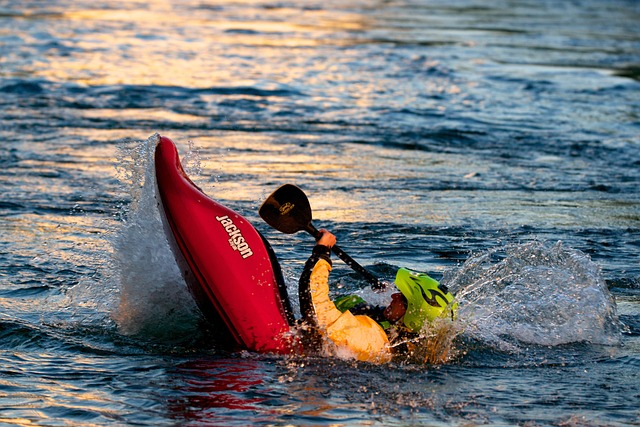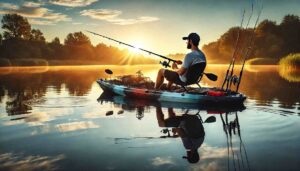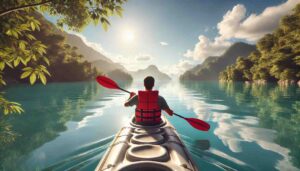Kayaking is a thrilling outdoor activity that allows you to explore the beauty of waterways, from serene lakes to rushing rivers. For many, it’s a fantastic way to connect with nature, get some exercise, and enjoy the great outdoors. However, a common question that arises among beginners is, “Do you need to know how to swim to kayak?”
Being a strong swimmer isn’t a prerequisite for kayaking. While it’s possible to kayak if you can’t swim, it’s wise to at least learn basic water-kicking techniques. However, the most important rule for everyone, swimmers and non-swimmers alike is to consistently wear a buoyancy aid while kayaking.
This article aims to address this question comprehensively, taking into consideration safety, skills, and the different aspects of kayaking.
Safety First: The Importance of Knowing How to Swim
Before delving into the details of whether you need to know how to swim to kayak, it’s essential to emphasize the paramount importance of water safety. Regardless of your proficiency in swimming, engaging in water-related activities, such as kayaking, demands a fundamental understanding of water safety principles. Here’s why:
- Accidents Can Happen: Even experienced kayakers can find themselves in challenging situations. Unpredictable factors like changing weather conditions, strong currents, or unexpected obstacles can lead to capsizing or other emergencies.
- Self-Rescue: Knowing how to swim allows you to better manage emergencies. If you fall out of your kayak, being a confident swimmer gives you the ability to swim to safety, reach your kayak, or assist others in your group.
- Comfort and Confidence: Being a swimmer increases your overall comfort and confidence in the water. This comfort can help you stay relaxed and focused while kayaking, enhancing your overall experience.
- Water Awareness: Swimming helps you develop a sense of water awareness, which is crucial for understanding currents, eddies, and the dynamics of the water environment you’re paddling in.
While knowing how to swim is highly recommended for kayaking, it’s not necessarily a strict requirement. Many kayakers who aren’t strong swimmers have successfully enjoyed the sport by taking extra precautions and focusing on building their skills.
Building Confidence in the Water
If you’re interested in kayaking but aren’t a strong swimmer, there are steps you can take to build your confidence in the water. These steps can help you enjoy kayaking safely:
- Learn to Swim: Enroll in swimming lessons to develop your swimming skills. Becoming a proficient swimmer is an excellent foundation for any water-based activity.
- Take a Safety Course: Consider taking a water safety course or kayaking lesson from a certified instructor. These courses typically cover essential safety practices, including what to do in case of capsizing.
- Wear a Personal Flotation Device (PFD): Always wear a properly fitted PFD when kayaking. A PFD provides buoyancy and can keep you afloat even if you’re not a strong swimmer.
- Stay Close to Shore: If you’re not confident in your swimming abilities, stick to calm, shallow waters near the shore. This minimizes the risk and allows you to gradually build your skills and confidence.
- Paddle with Experienced Kayakers: Kayaking with experienced paddlers can provide you with a safety net. They can offer guidance, support, and assistance if needed.
- Practice Self-Rescue: Learn how to re-enter your kayak from the water. This skill is essential in case you ever capsize.
Skills for Safe Kayaking
Aside from swimming ability, there are various kayaking skills that can contribute to your safety and enjoyment on the water. These skills include:
- Paddling Techniques: Proper paddling techniques help you maneuver your kayak efficiently and reduce the risk of capsizing. Learning how to paddle correctly is essential for beginners.
- Balance and Stability: Maintaining balance is crucial in kayaking. Practice shifting your weight and getting comfortable in your kayak to prevent tipping.
- Bracing: A good bracing technique involves using your paddle to prevent capsizing. It’s a skill that can help you recover from a potential flip.
- Reading Water: Understanding water conditions, such as currents, eddies, and obstacles, is essential for safe kayaking. This knowledge allows you to plan your route and make informed decisions.
- Rescue Techniques: Familiarize yourself with rescue techniques, including how to assist others and self-rescue methods like the “wet exit” (getting out of a capsized kayak).
- Navigation: Basic navigation skills can help you stay on course and avoid getting lost in unfamiliar waterways.
- Weather Awareness: Keep an eye on weather forecasts and be prepared for changing conditions. Sudden storms or strong winds can make kayaking more challenging.
- Communication: Establish clear communication with your paddling companions. Signals and verbal cues are essential for coordinating movements and addressing emergencies.
- Equipment Familiarity: Understand your kayak and its equipment, including how to adjust the footrests, use the rudder (if applicable), and secure your gear.
- Group Dynamics: If kayaking in a group, communicate and coordinate with others. Stick together and ensure everyone is aware of the plan and safety procedures.
By acquiring these skills and knowledge, you can mitigate risks and enjoy kayaking with confidence, even if you’re not a strong swimmer.
Types of Kayaking and Swimming Skills
The type of kayaking you plan to pursue can also influence the importance of swimming skills. There are various forms of kayaking, each with its own demands and safety considerations:
- Recreational Kayaking: Recreational kayaking typically involves calm waters, such as lakes and slow-moving rivers. While swimming skills are beneficial, they are not as critical as they would be in more challenging conditions.
- Sea Kayaking: Sea kayaking involves paddling in open waters, often along coastlines. Swimming skills are important here because you may encounter stronger currents and changing weather conditions.
- Whitewater Kayaking: Whitewater kayaking takes place on fast-flowing rivers with varying degrees of difficulty. In this context, strong swimming skills are essential, as capsizing is more common, and you must be able to navigate in turbulent water.
- Touring Kayaking: Touring kayaking typically involves longer trips on various water bodies. Swimming skills are advisable, especially if you plan to venture into larger bodies of water like oceans and large lakes.
- Kayak Fishing: If you’re combining kayaking with fishing, knowing how to swim is essential, as you’ll be dealing with hooks, lines, and the added challenge of potentially reeling in fish while in a kayak.
In summary, the type of kayaking you choose to pursue should be considered when evaluating the necessity of swimming skills. More challenging forms of kayaking, such as whitewater or sea kayaking, place a higher premium on swimming proficiency.
Safety Precautions for Non-Swimmers
If you’re committed to kayaking but lack strong swimming skills, there are specific safety precautions you should take to ensure a safe and enjoyable experience:
- Wear a PFD at All Times: Emphasizing this point again, always wear a properly fitted personal flotation device (PFD) while kayaking. It provides buoyancy and can keep you afloat even if you’re not a strong swimmer.
- Stay in Calm Waters: Stick to calm and shallow waters, especially when starting out. Gradually progress to more challenging conditions as your skills and confidence improve.
- Paddle with Others: Whenever possible, paddle with experienced kayakers or a group. They can offer assistance in case of emergencies.
- Inform Someone of Your Plans: Before heading out, let someone know your kayaking plans, including your route and estimated return time. This ensures that someone can raise the alarm if you don’t return as expected.
- Carry Safety Equipment: Carry essential safety equipment, such as a whistle, signaling devices, and a first-aid kit, in case of emergencies.
- Take a Safety Course: Consider enrolling in a kayaking safety course or participating in guided trips led by experienced instructors.
- Practice Self-Rescue: Learn how to re-enter your kayak from the water and practice this skill in controlled conditions.
- Monitor Weather Conditions: Stay informed about weather forecasts and avoid kayaking in adverse conditions.
- Use a Sit-On-Top Kayak: Sit-on-top kayaks are more stable and easier to re-enter in case of capsizing. They can be a good choice for beginners or non-swimmers.
- Stay Close to the Shore: Keep near the shoreline so that you can quickly reach safety if needed.
Remember that kayaking is an enjoyable and accessible activity for people of various skill levels. By taking these safety precautions and gradually building your skills, you can experience the joys of kayaking without being a strong swimmer.
Swimming and Kayaking: A Synergistic Approach
While swimming skills can certainly enhance your safety and confidence as a kayaker, it’s worth noting that kayaking itself can also improve your swimming abilities. Here’s how:
- Water Comfort: Kayaking regularly exposes you to water environments, gradually increasing your comfort level in the water.
- Water Awareness: As a kayaker, you become more attuned to water conditions, currents, and hazards. This heightened awareness can also benefit you when swimming.
- Rescue Skills: Learning how to self-rescue and assist others in kayaking emergencies can provide valuable lifesaving skills that extend beyond kayaking.
- Fitness Benefits: Kayaking is a great workout for your upper body and core muscles. Improved fitness can contribute to better swimming abilities.
- Confidence: The confidence gained through kayaking can positively influence your attitude toward swimming and water-related activities.
Conclusion
In answer to the question, “Do you need to know how to swim to kayak?” the answer is that while it’s highly recommended, it’s not an absolute requirement. Knowing how to swim significantly enhances your safety and confidence as a kayaker, especially if you plan to explore more challenging waters. However, with proper precautions, safety measures, and skill development, individuals who aren’t strong swimmers can still enjoy kayaking safely.
Ultimately, the key is to prioritize water safety, build your skills gradually, and choose kayaking experiences that align with your level of proficiency. Whether you’re a seasoned swimmer or working on your swimming abilities, kayaking offers an exciting way to connect with nature and explore the wonders of our waterways.










